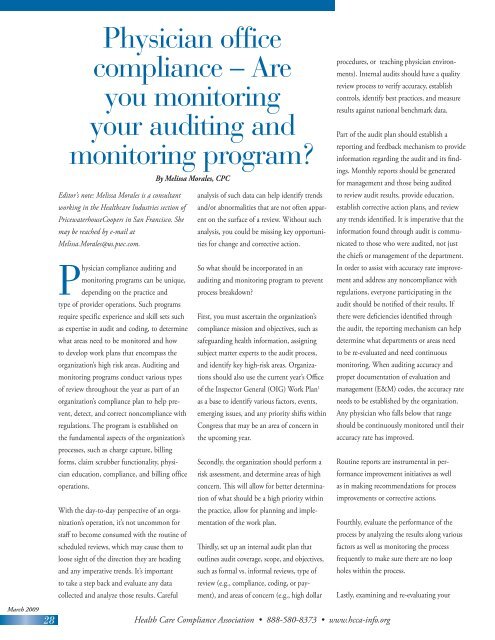BP - Health Care Compliance Association
BP - Health Care Compliance Association
BP - Health Care Compliance Association
Create successful ePaper yourself
Turn your PDF publications into a flip-book with our unique Google optimized e-Paper software.
Physician office<br />
compliance – Are<br />
you monitoring<br />
your auditing and<br />
monitoring program?<br />
Editor’s note: Melissa Morales is a consultant<br />
working in the <strong>Health</strong>care Industries section of<br />
PricewaterhouseCoopers in San Francisco. She<br />
may be reached by e-mail at<br />
Melissa.Morales@us.pwc.com.<br />
Physician compliance auditing and<br />
monitoring programs can be unique,<br />
depending on the practice and<br />
type of provider operations. Such programs<br />
require specific experience and skill sets such<br />
as expertise in audit and coding, to determine<br />
what areas need to be monitored and how<br />
to develop work plans that encompass the<br />
organization’s high risk areas. Auditing and<br />
monitoring programs conduct various types<br />
of review throughout the year as part of an<br />
organization’s compliance plan to help prevent,<br />
detect, and correct noncompliance with<br />
regulations. The program is established on<br />
the fundamental aspects of the organization’s<br />
processes, such as charge capture, billing<br />
forms, claim scrubber functionality, physician<br />
education, compliance, and billing office<br />
operations.<br />
With the day-to-day perspective of an organization’s<br />
operation, it’s not uncommon for<br />
staff to become consumed with the routine of<br />
scheduled reviews, which may cause them to<br />
loose sight of the direction they are heading<br />
and any imperative trends. It’s important<br />
to take a step back and evaluate any data<br />
collected and analyze those results. <strong>Care</strong>ful<br />
By Melissa Morales, CPC<br />
analysis of such data can help identify trends<br />
and/or abnormalities that are not often apparent<br />
on the surface of a review. Without such<br />
analysis, you could be missing key opportunities<br />
for change and corrective action.<br />
So what should be incorporated in an<br />
auditing and monitoring program to prevent<br />
process breakdown?<br />
First, you must ascertain the organization’s<br />
compliance mission and objectives, such as<br />
safeguarding health information, assigning<br />
subject matter experts to the audit process,<br />
and identify key high-risk areas. Organizations<br />
should also use the current year’s Office<br />
of the Inspector General (OIG) Work Plan 1<br />
as a base to identify various factors, events,<br />
emerging issues, and any priority shifts within<br />
Congress that may be an area of concern in<br />
the upcoming year.<br />
Secondly, the organization should perform a<br />
risk assessment, and determine areas of high<br />
concern. This will allow for better determination<br />
of what should be a high priority within<br />
the practice, allow for planning and implementation<br />
of the work plan.<br />
Thirdly, set up an internal audit plan that<br />
outlines audit coverage, scope, and objectives,<br />
such as formal vs. informal reviews, type of<br />
review (e.g., compliance, coding, or payment),<br />
and areas of concern (e.g., high dollar<br />
procedures, or teaching physician environments).<br />
Internal audits should have a quality<br />
review process to verify accuracy, establish<br />
controls, identify best practices, and measure<br />
results against national benchmark data.<br />
Part of the audit plan should establish a<br />
reporting and feedback mechanism to provide<br />
information regarding the audit and its findings.<br />
Monthly reports should be generated<br />
for management and those being audited<br />
to review audit results, provide education,<br />
establish corrective action plans, and review<br />
any trends identified. It is imperative that the<br />
information found through audit is communicated<br />
to those who were audited, not just<br />
the chiefs or management of the department.<br />
In order to assist with accuracy rate improvement<br />
and address any noncompliance with<br />
regulations, everyone participating in the<br />
audit should be notified of their results. If<br />
there were deficiencies identified through<br />
the audit, the reporting mechanism can help<br />
determine what departments or areas need<br />
to be re-evaluated and need continuous<br />
monitoring. When auditing accuracy and<br />
proper documentation of evaluation and<br />
management (E&M) codes, the accuracy rate<br />
needs to be established by the organization.<br />
Any physician who falls below that range<br />
should be continuously monitored until their<br />
accuracy rate has improved.<br />
Routine reports are instrumental in performance<br />
improvement initiatives as well<br />
as in making recommendations for process<br />
improvements or corrective actions.<br />
Fourthly, evaluate the performance of the<br />
process by analyzing the results along various<br />
factors as well as monitoring the process<br />
frequently to make sure there are no loop<br />
holes within the process.<br />
Lastly, examining and re-evaluating your<br />
March 2009<br />
28<br />
<strong>Health</strong> <strong>Care</strong> <strong>Compliance</strong> <strong>Association</strong> • 888-580-8373 • www.hcca-info.org

















